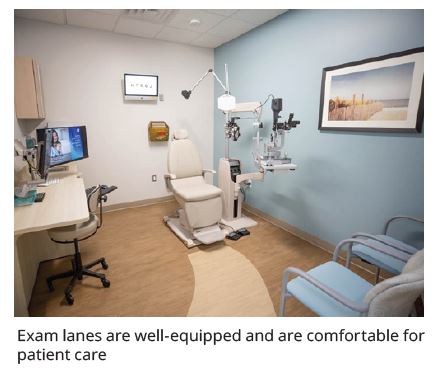with the help of a Nurse Turned Pioneer in Clinical Design
Duke Eye Center opened a 14,000 square foot clinic in May 2021 located in the new Duke Health Arringdon, a multi-specialty clinical facility that includes an ambulatory surgery center (ASC) for a wide range of outpatient surgery.
The new state-of-the art Duke Eye Center clinic offers cornea, glaucoma, and retina subspecialties, features 25 eye lanes, six rooms for injections and lasers, minor surgical procedures, as well as a large room for laser refractive surgery. The open-concept design includes workspace areas to encourage relationship and team building, as well as plenty of natural light and beautiful landscape views of Morrisville and Research Triangle Park. The Duke Ambulatory Surgery Center located on the fifth floor of the building will serve patients that require surgical procedures.
Duke Eye Center Arringdon, like other satellite locations, aims to bring multiple specialties to patients in their own communities to meet the needs of the exponential growth of the region. This is the sixth satellite clinic for Duke Eye Center. Additional clinics are planned to span across the region in the coming years.
Arringdon was designed with the help of Kim Denty, RN, MSN, a pioneer in clinical design and an expert in patient safety. She has assisted in the design of six clinics for Duke Eye Center, from upfitting new space to remodeling existing space. With each project, she adheres to a common theme – commitment to a safe, functional, environmentally friendly, cost-effective space to enhance the patient experience and make delivery of care more efficient.
“We have been so fortunate to have Kim’s expertise when designing our clinics. She is amazing and really does take the whole operation into consideration. Each clinic has Kim’s unparalleled touch and attention to detail. We could not be prouder of what she has done to make our clinics as efficient, safe, and economical as possible,” says Heidi Campbell, COT, director of operations for Duke Eye Center.
Denty began her career as a staff nurse and then held administrator roles in the Cancer Center at Duke Health. She has a passion for clinical design – even if she didn’t quite know it when she started as a staff nurse. At the time, the Cancer Center was in Duke South, the original home of Duke University Hospital. Denty remembers struggling with her daily work due to the clinic’s inefficient design. What she realized is that most building architects do not have clinical operations experience and do not fully understand why it is so important to pay attention to certain details.
“When I worked in clinic, I was always taking things apart, moving walls, moving equipment to help patients and staff maneuver in the clinic,” she describes. The rooms were small and made it difficult to perform patient care – it became extremely challenging in a space that could barely accommodate patients, their families, physicians, residents, and nurses.
Denty continued to enhance facilities while also working in clinical administrator roles and a patient safety advocate.
When the opportunity came along for her to become the Associate Vice President for Clinical Site Development and Patient Safety for the Private Diagnostic Clinic (PDC), the physician practice of Duke Health, Denty jumped at the chance spend her days making clinics safer and more comfortable for both patients and providers. While in the site development role, Denty has been responsible for designing multiple new Duke Health multi-specialty buildings which totals hundreds of thousands of square feet. Arringdon alone has 70,000 square feet of clinical space.
 Denty retired in November 2021 to slow the pace of hectic long hours and reflect on the positive impact she made at Duke.
Denty retired in November 2021 to slow the pace of hectic long hours and reflect on the positive impact she made at Duke.
“We will miss Kim being a part of our clinical designs going forward but are forever grateful for the extraordinary expertise she has shared to improve the patient experience,” says Eric Postel, MD, professor of ophthalmology and vice chair for clinical affairs.
Denty approaches clinical designs as an all-inclusive effort – considering efficiency of operations, providers, staff, but ultimately, decisions are made based on patient care, safety and patient feedback, and long-term goals of the clinic.
“For me, it's always been about patients, and when I think about a clinic –– how patients get around clinics, whether they're in a wheelchair, on crutches, visually impaired, or just walking normally,” Denty said. “Everything begins with the patient, and it always begins with the front door, all the way through to the end when they check out.”
For instance, Denty will “light the way” down long hallways and in exam rooms and using contrasting flooring to help low-vision patients navigate the clinic.
 Another aspect of clinic design involves ensuring a good return on investment. Some examples include, installing sliding “barn doors” for exam lanes which reduced the amount of space needed for a traditional door to swing open, which in turn allowed for an increased number of exam lanes in the clinic. She selects sustainable materials for flooring and furniture to easily clean and sanitize and reduce ongoing maintenance and chemical footprint. She implemented an electronic fire extinguisher monitoring system to maintain fire extinguisher records that used to be handled by staff, which took them away from patient care.
Another aspect of clinic design involves ensuring a good return on investment. Some examples include, installing sliding “barn doors” for exam lanes which reduced the amount of space needed for a traditional door to swing open, which in turn allowed for an increased number of exam lanes in the clinic. She selects sustainable materials for flooring and furniture to easily clean and sanitize and reduce ongoing maintenance and chemical footprint. She implemented an electronic fire extinguisher monitoring system to maintain fire extinguisher records that used to be handled by staff, which took them away from patient care.
Contrasting flooring, handrails, and other ADA compliant safety features for fall prevention
- Exam chairs that glide and can be moved to accommodate a wheelchair
- Sliding barn style doors to maximize space in the exam lanes
- Comfortable soothing color scheme to put patients at ease
- Use of sustainable materials to reduce chemical footprint and long-term cost savings
Although each new clinic presents a new challenge, Denty says she feels fortunate to have the opportunity to impact so many clinics at Duke. She also encourages others with a clinical background to think about how they can apply their skills to facility design.
“I know it doesn't sound exciting for nursing to get involved in architecture or construction, but I'll tell you, I don't think there's a more important job,” she says. “I love the fact that when I walk into a clinic, and I see patients comfortably sitting in chairs, that I feel like I was a part of helping them to get safe, quality health care in a great environment,” says Denty.
